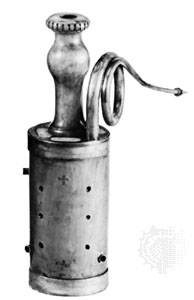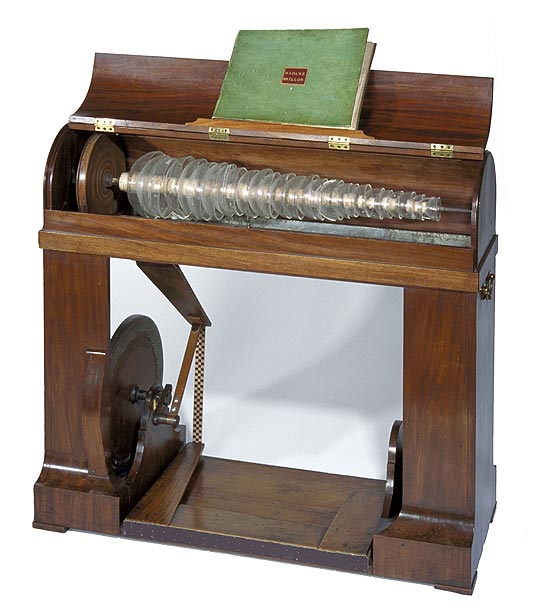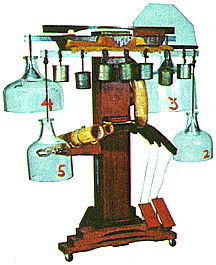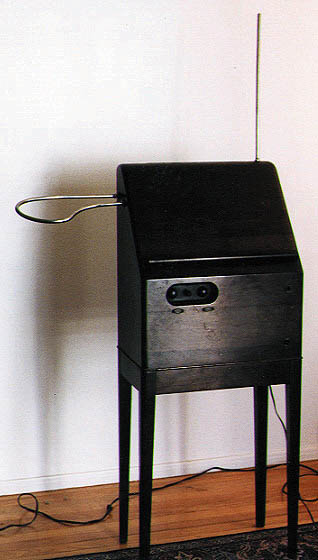 No, itís not a water pipe. Itís a rackett.
No, itís not a water pipe. Itís a rackett.
 No, itís not a water pipe. Itís a rackett.
No, itís not a water pipe. Itís a rackett.
If youíve ever wondered what Renaissance composers were smoking, the answer is probably nothing, at least using this. This is a small hand-held double reed instrument popular in the 16th and 17th centuries. It was probably the bass instrument in an ensemble of winds. If youíre curious about purchasing one, they cost about $1,700.
Benjamin Franklin (yeah! The guy with the kites) also invented an instrument based on the old idea of rubbing your fingers around the edges of crystal glasses to produce tones. His instrument was known as the Glass Harmonica. He worked with London glassblower Charles James to build one, and it had its world premiere in early 1762, played by Marianne Davies.

In Franklin's version, 37 bowls were mounted horizontally nested on an iron spindle. The whole spindle turned by means of a foot-operated treadle. The sound was produced by touching the rims of the bowls with moistened fingers. Rims were painted different colors according to the pitch of the note. A's were dark blue, B's purple, C's red, D's orange, E's yellow, F's green, G's blue, and accidentals white. With the Franklin design it is possible to play ten glasses simultaneously if desired, a technique that is very difficult if not impossible to execute using upright goblets. Franklin also advocated the use of a small amount of powdered chalk on the fingers which helped produce a clear tone in the same way rosin is applied to the bows of string instruments.
 Harry Partch
Harry Partch
Harry Partch was a brilliant musician and inventor. He lived from 1901-1974. He built most of his instruments in the 1940s and 50s. If you want to hear a sampler of some of his most interesting creations, find a copy of the Columbia recording called The Delusion of the Fury. It contains a bonus LP with about 50 minutes of Partch demonstrating his instruments.
One of his strangest is The Spoils of War, pictured below.

The central post in the instrument is the resonator. On top of it is a 27-inch Pernambuco block which sounds an A, one octave above the piano's lowest A. The small redwood block in front gives an approximate C#, third above middle C. The seven brass artillery casings give a microtonal sequence from a flat C#, third above middle C, to the next D. The two cloud-chamber bowls are separated by about a semitone A -- A-flat. The whang-gun, on the left, is a piece of spring steel controlled by a pedal, and makes a 'whang" sound. The raspador is also on the left. Played with a variety of mallets.
 Theremin
Theremin
This instrument was created by a Russian named Leon Theremin in 1919. It is an electronic device and the sounds are created by moving the hands toward and away from the horizontal and vertical antennae (one controls frequency; the other volume).. It was used on many film soundtracks, including
The Day the Earth Stood Still, Spellbound, Forbidden Planet, The Lost Weekend, and Ed Wood. For more information about the theremin, go to Theremin World
 The wild and crazy Pikasso guitar
The wild and crazy Pikasso guitar
This is an instrument created by Linda Manzer for Pat Metheny. It gets its name from the fact that it looks like Picassoís cubist paintings. It has four necks, two sound holes, 42 strings. Two access doors; one on the upper player's side and one at the tail block.
It took 2 years to build (approximately 1000 hours), and when the 42 strings are strung up to high tension, the Pikasso is under approximately 1000 lbs pressure. It weighs 6.7 kg or 14 3/4 lbs. Please visit Linda Manzerís website at www.manzer.com
If you need to leave, Go to initial page of site.
If you are interested in advertising a music-related business in the pages of the classroom, please send us an e-mail regarding rates by clicking here.